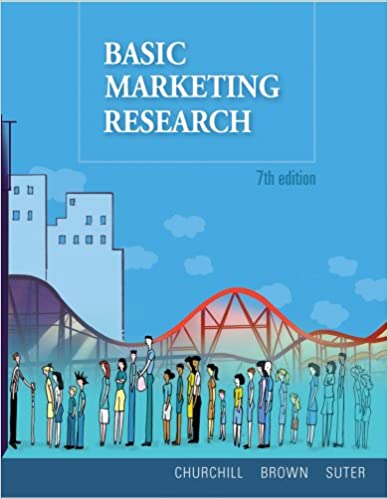
Basic Marketing Research 7th Edition by Gilbert Churchill,Tom Brown,Tracy Suter
Edition 7ISBN: 978-1439041390
Basic Marketing Research 7th Edition by Gilbert Churchill,Tom Brown,Tracy Suter
Edition 7ISBN: 978-1439041390 Exercise 11
What do the following two research situations have in common
Situation I: The Bugs-Away Company marketed successful insect repellents. The products were effective and leaders in the market. They were available in blue aerosol cans with red caps. The instructions, in addition to a warning to keep the product away from children, were clearly specified on the container. Most competitors produced similar products in similar containers. The CEO of Bugs-Away was worried because of declining sales and shrinking profit margins. Another issue of concern was that companies such as hers were being severely criticized by govermnent and consumer groups for their use of aerosol cans. The CEO contacted the company's advertising agency and requested that it do the necessary research to find out what was happening.
Situation II: In early 2008, the directors of Adams University were considering an expansion of the business school due to increasing enrollments over the past 10 years. Their plans included constructing a new wing, hiring five new faculty members, and increasing the number of scholarships from 100 to 120. The funding for this ambitious project was to be provided by some private sources, internally generated funds, and state and federal governments. A previous research study (completed in 1998), using a sophisticated forecasting methodology, indicated that student enrollment would peak in 2006. Another study, conducted in November 2002, indicated that universities could expect gradual declining enrollments until roughly the year 2013. The directors were concerned about the results of the later study and the talk it stimulated about budget cuts by the government. A decision was made to conduct a third and final study to determine likely student enrollment.
Situation I: The Bugs-Away Company marketed successful insect repellents. The products were effective and leaders in the market. They were available in blue aerosol cans with red caps. The instructions, in addition to a warning to keep the product away from children, were clearly specified on the container. Most competitors produced similar products in similar containers. The CEO of Bugs-Away was worried because of declining sales and shrinking profit margins. Another issue of concern was that companies such as hers were being severely criticized by govermnent and consumer groups for their use of aerosol cans. The CEO contacted the company's advertising agency and requested that it do the necessary research to find out what was happening.
Situation II: In early 2008, the directors of Adams University were considering an expansion of the business school due to increasing enrollments over the past 10 years. Their plans included constructing a new wing, hiring five new faculty members, and increasing the number of scholarships from 100 to 120. The funding for this ambitious project was to be provided by some private sources, internally generated funds, and state and federal governments. A previous research study (completed in 1998), using a sophisticated forecasting methodology, indicated that student enrollment would peak in 2006. Another study, conducted in November 2002, indicated that universities could expect gradual declining enrollments until roughly the year 2013. The directors were concerned about the results of the later study and the talk it stimulated about budget cuts by the government. A decision was made to conduct a third and final study to determine likely student enrollment.
Explanation
Continuous detection and track of change...
Basic Marketing Research 7th Edition by Gilbert Churchill,Tom Brown,Tracy Suter
Why don’t you like this exercise?
Other Minimum 8 character and maximum 255 character
Character 255


